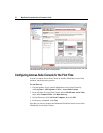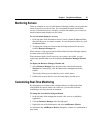
80 MetaFrame Presentation Server Reviewer’s Guide
Introducing Load Manager Rules
Administrator-defined rules provide the framework to determine server load. For
example, you can set the rule called server user load to be considered full at 100
users. When this limit is reached, the server is not available for additional
connections.
The rules included in Load Manager are:
• Application user load
• Context switches
• CPU utilization
• Disk data I/O
• Disk operations
• IP range
• Memory usage
• Page faults
• Page swaps
• Scheduling
• Server user load
Load evaluators are made up of one or more rules and their load settings. You
create load evaluators to perform customized load management tasks and then
attach them to servers. You can create as many load evaluators as you need for
optimum server or published application performance. However, each server can
have only one load evaluator attached to it. Load evaluators can vary on each
server, and each load evaluator can contain any combination of rule types and
values.
Working With Load Evaluators
The Default and Advanced load evaluators are predefined evaluators that cannot be
modified. The Default load evaluator contains one rule—server user load—that
reports a full load when 100 users log on to the server. The Default load evaluator is
attached to your server by default when you activate your Advanced or Enterprise
Edition license, enabling Load Manager. You can create new load evaluators for
your specific needs.


















